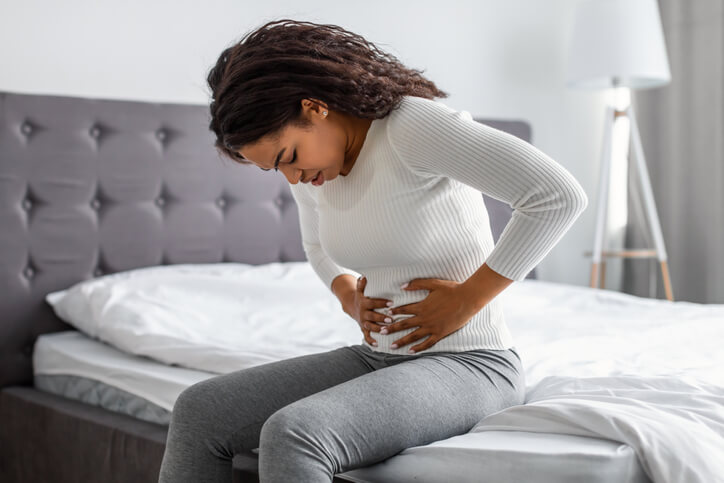Cramping is a common, frustrating symptom of many different underlying conditions.
But crampes are notoriously related to pregnancy and menstruation. Whether you’re trying for a baby or not, it’s important to know the difference between these two types of cramps.
Here’s everything you need to know about the different signs and symptoms of period cramps and pregnancy cramps so you can have a better understanding of what’s going on inside your body.
What Causes Pregnancy Cramps?
It’s no secret that the body goes through many changes when pregnant.
After all, the body needs to shift and morph to support, make room for, and accommodate an entirely new human being inside of you.
Among the many symptoms are twinges or painful pelvic tension, which is known as implantation cramping. Implantation is the process of the fertilized egg implanting in the uterus during early pregnancy.
You may also experience implantation bleeding, which can seem like a menstrual period. Taking a home pregnancy test can help you tell the difference.
It’s important to remember that the uterus is a muscle that can contract to cause pain or discomfort like any other.
Cramping during pregnancy is due to the uterine wall growing and expanding to accommodate the growing baby. In fact, this is a very healthy symptom that means everything is moving along as it should be.
What Causes Period Cramps?
Period cramps, or menstrual cramps, are often considered one of the most uncomfortable symptoms of PMS (premenstrual syndrome).
While you need your uterine lining during pregnancy, a period is indicative that you aren’t childbearing. For that reason, the uterus expels its lining during menstruation.
So what does that have to do with cramping? The uterine muscle contracts during your period to make it easier to expel its lining, which results in feelings of tightness or pain.
This uterine contraction is triggered by hormone-like substances called prostaglandins.
These are involved in pain and inflammation, and higher levels of prostaglandins are associated with more severe cramping.
How To Tell the Difference Between Period Cramps and Pregnancy Cramps
The main difference between period cramps and pregnancy cramps is the cause.
During period cramps, the uterus contracts because it doesn’t need to make room for a baby. In pregnancy cramps, the uterus expands because it needs to make room for one.
But despite their opposite causes, the sensations can be nearly identical.
That said, cramping due to implantation or pregnancy is typically milder in intensity than period cramps.
Period cramps can range from moderate to severe depending on the level of prostaglandins in your system. Period cramps also often come with lower back pain and bloating. These symptoms can help you to determine what cramps you are experiencing.
In some cases, implantation cramping doesn’t even feel like a cramp in the first place.
It might only feel like a light pulling, tingling, or prickling. The sensation is a helpful indicator to tell the difference between the two.
However, you might also be able to tell the difference by pairing the abdominal cramping with some other co-occurring symptoms that are specific to one or the other.
Normal Pregnancy Cramps vs. Abnormal Pregnancy Cramps
Cramping during pregnancy is usually normal, but it can also signify that something is wrong.
Normal pregnancy cramps are generally mild, and there is less cramping during the second trimester compared to the first trimester.
Additionally, if you’re bearing two or more children, the cramping might feel more severe as the uterus expands to make more room.
If a cramp feels severe or it’s persistent and won’t go away, you should consult your doctor just to be safe.
Sometimes, a severe cramp can signify an ectopic pregnancy in which the fertilized egg implants outside the uterine cavity. Ectopic pregnancies are a serious condition that requires immediate surgery.
Additionally, cramping should not coincide with heavy vaginal bleeding.
While light bleeding and spotting are normal during pregnancy, severe cramping and bleeding might signify a miscarriage. Finally, you should consult a doctor if you feel cramping on just one side of the body.
As a general rule of thumb, never be afraid to contact your healthcare provider if you feel like anything is out of the ordinary. When it comes to childbearing, you can never be too thorough.
Other Early Symptoms of Pregnancy
It is easy to mistake period cramping or the symptoms of menstruation for the early signs of pregnancy. However, there are some early pregnancy symptoms to be aware of to get the support you need in the early stages.
Missed Period
The most telltale sign of a pregnancy is that you miss an expected menstrual cycle.
If you’re in childbearing years and a week or more has passed without your period starting, then it might be time to go to your local drugstore for a home pregnancy test. This symptom can be hard to recognize in women with irregular periods.
Morning Sickness
Another common symptom of pregnancy is nausea and vomiting, often referred to as “morning sickness.”
Despite its name, this symptom can occur anytime, even in the afternoons or nights. While this is more common around six weeks, some women still feel nausea at earlier stages.
Fatigue
The human body undergoes lots of changes, both physically and mentally, when undergoing pregnancy.
And the drastic shifts in hormones (like estrogen, progesterone, and HCG) can majorly affect energy levels.
That’s why tiredness is a common symptom of pregnancy that might co-occur with cramping and discomfort.
Pregnancy is also associated with a rise in sleep disorders, making individuals much drowsier throughout the day.
Increased Urination
You’re doing something right if you find yourself in the bathroom more often than not.
There are many reasons urination increases during pregnancy, including the fact that the body produces more fluids, the kidneys become more efficient, and the uterus pushes against the bladder as it expands.
Tender, Swollen Breasts
Hormonal changes during early pregnancy can make the breasts more sensitive and sore.
While breast tenderness will likely decrease after a few weeks, this is often a common sign that you might feel at the same time as implantation cramping.
In Conclusion
Cramping during pregnancy and menstruation can feel nearly identical. Still, it’s essential to know the difference between the two, so you can have a better understanding of what’s going on inside of your body.
Pregnancy cramps are caused by the uterine wall expanding to make room for a baby, whereas period cramps are caused by the uterus contracting to make it easier to expel its lining.
The main difference between cramps is that period cramps often feel more severe than pregnancy cramps.
Normal pregnancy cramping is mild and doesn’t coincide with any heavy bleeding.
If pregnancy cramps feel severe, or if you notice a lot of bleeding, be sure to contact your OB-GYN (gynecologist) immediately to ensure everything is functioning as it should be.
References, Studies and Sources:
Menstrual cramps – Symptoms and causes | The Mayo Clinic.
Morning sickness | March of Dimes
Sleep disorders in pregnancy | PMC
When Should Cramps During Pregnancy Be Worrisome? | WFMC Health.

Bridget Reed is a Tampa-based content development manager, writer, and editor at GR0; specializing in content related to varying fields including medicine, health, and small businesses. Bridget went to St. Petersburg College and majored in Management and Organizational Leadership.
Recent Publications: Body Acne 101: Prevention and Treatment, Stress Acne: Causes, Prevention, and Treatment, What are the Side Effects of Midol?

